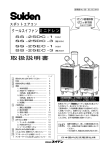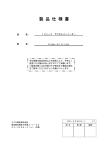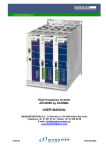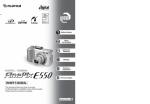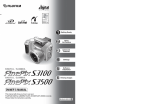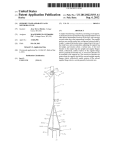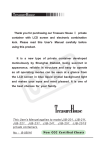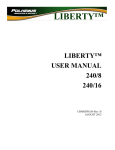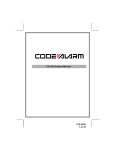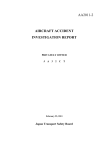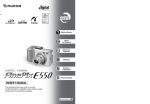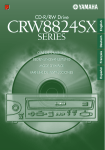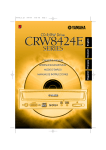Download Herutu TWF-700R
Transcript
Poka-yoke (Foolproofing) Receiver TWF-700R-ES (Engineering Sample) User's Manual V1.00 TWF-700R 1. Before You Use this Device 1-1 Introduction This operation manual contains necessary information for using the product, such as general description, installation, and operation of the product. Read the manual carefully before using the product. Also, keep it at a safe place for ready reference at anytime. 1-2 Accessories ・Antenna 1piece <Available Accessory> ・AC adaptor (Input AC100-240V/Output DC24V) 1-3 Safety precautions (Be sure to read) The description here highlights the precautionary matters which must be strictly observed in order to prevent physical harm to the user or other persons and damage to the property. The following pictorial symbols are used to classify and explain the criticality levels of harms or damages that may result from using the product in an improper way while ignoring the instructions. ! Caution The Caution indication means that “failure to observe the instructions may result in human injury, or physical damage alone.” For handling this machine: z This machine is a wireless communication device composed of precision parts. Do not overhaul/remodel. It may cause an accident or a machine trouble. Prohibited For working/storage environment: z To minimize the possibility of trouble, characteristic degradation, fire, or electrical shock, avoid using or storing the product in the following locations: • Locations subject to direct sunlight. Prohibited • Locations where liquids, foreign objects, corrosive gas, or flammable gas may enter the product. • Locations exposed to high humidity, oily smoke, dust, sand, or the like. • Locations with less stability such as the top surface of an unsteady table or an inclined surface. ! Warning The Warning indication means that “failure to observe the instructions may result in death or serious injury.” For handling this machine: z Do not use this product for such applications as require an extremely high level of reliability relating to human life. Prohibited Prohibited 1 TWF-700R z Do not use this product in locations where there is uncertainty about the coverage of radio waves. For handling the power supply: Always observe the following precautions to prevent the power cord from being heated, damaged, or ignited. z Do not bring the power cord close to fire nor put it into fire. may be broken or ignited, resulting in an accident. The power cord Prohibited z Use the AC adapter and the main body only with the specified power voltage to protect them against damage or fire accidents. z Do not use the main body in a wettable atmosphere. It may cause accidents or troubles such as heating, igniting, and electrical shock. z Do not touch the main body, the power cord, or the plug outlet with wet hands. It may lead to accidents such as electrical shock. z Do not damage the power cord. fire or electrical shock. Prohibited Prohibited Prohibited A short circuit or heating may result, causing Prohibited z Do not use the power plug with dust adhered on it. A short circuit or heating may result, causing fire or electrical shock. z Do not give a strong impact onto the power cord. It may cause an accident or a machine trouble. z Do not use the power cord if you find out deformation etc. in it. It may cause an accident or a machine trouble. z Do not charge the main body in locations where flammable gas could be generated. It may result in igniting or a fire accident. z Never overhaul the main body. It may cause an accident or a machine trouble. Prohibited Prohibited Prohibited Prohibited Prohibited When something erroneous has occurred during use: Since it may cause fire, electrical shock, or the like, remove the power plug from the plug outlet and ask the outlet store or us for repair. z When smoke or abnormal odors come out, immediately remove the power plug from the plug outlet and ask the outlet store or us for repair. z Do not use the power cord if it is damaged. U s i n g the damaged power cord may result in fire or electric shock. 2 Attention Prohibited TWF-700R • Terms Used in this Manual This section defines the special terms that are used in this manual. Terminology Explanation Transmitter Refers to the TWF-600T. The transmitter can be attached to a variety of tools, such as torque wrenches and pliers. Tool In this manual, “tool” refers to any tool that has a transmitter attached to it. Work Refers to the number of movements of a tool. ID Refers to the unique numbers that are assigned to each TWF-600T. Code 39 Refers to the Code 39 barcode standard. RS-232C Refers to the RS-232C serial communication standard. 3 TWF-700R 1-4. General Description The TWF-700R poka-yoke (foolproofing) receiver (hereinafter referred to as “the receiver”) can receive signals from TWF-600T transmitters, count tool movements according to diffe rent configurations, and produce pass/fail judgments based on the movements that it has counted. The receiver has three count modes, in which it keeps track of the number of tool move ments and produces pass/fail judgments based on them, and one through mode, in which it simply relays the signals that it receives from the transmitter. You can use each of th ese modes as necessary for different applications. The receiver indicates the judgment results by using LED lamps. The receiver can also tr ansmit the results to external devices, such as revolving lights or a signal tower. In additi on, the receiver is equipped with a serial port, and you can use it with a barcode reader to scan counting instructions. With the receiver, you can construct a simple poka-yoke (foolproofing) system within the production line without installing large-scale equipment. Features • Because the receiver can register four different transmitter IDs, you can use it in a gro up with four different transmitters. • The receiver has three count modes, in which it counts the number of tool movements, and one through mode, in which it simply relays the signal that it receives. You can u se these four different modes as necessary for different applications. Count modes Count judgment (mode 1) End input judgment (mode 2) Barcode mode (mode 3) Through mode (mode •Through Mode The receiver relays signals that it receives from the transmitters that have been registere d on it. Because the receiver can register up to four transmitter IDs, it can be used in a group with four transmitters. 4 TWF-700R •Count Modes You can select tools (transmitters) and amounts of work (number of tool movements) for each operation, and the receiver will produce pass/fail judgments that are based on the number of signals that it receives from the selected tools. In modes 1 and 2, you set the tool (transmitter) and amount of work (number of tool movements) by applying a signal to the receiver. In mode 3, you set the tool and amount of work using external serial input (based on a bar code). • The receiver operates on a frequency of 426.1 MHz. • The receiver's indoor communication range is approximately 50 m. 5 TWF-700R 1-5. Specifications Item Specifications Frequency 426.1 MHz (the same as the TWF-600T) Antenna Whip antenna with a BNC connector ID configuration (tool configuration) Key sheet Up to four TWF-600T IDs can be registered. 14 keys (0 to 9, CLR, ENT, +, -, S, T, and F1 to F4) Character LCD with backlight 16 characters × 2 lines 7-segment LED with 2 digits Counter 25-mm tall characters with red illumination Pass/fail Round, two-color lamp (red and green) judgment display lamp Green indicates pass. Red indicates fail. Sounds after each tool movement or pass/fail judgment Internal buzzer Buzzer frequency: Approx. 2.3 kHz Volume: 95 ± 10 dB (at a distance of 1 m) Four work selection connectors and one COM connector: (Five connectors) 16-point input Four tool selection connectors and one COM connector: (dry contact input) (Five connectors) The terminal block is the same as that used Three control signal connectors and one COM connector: (Four connectors) in the WCP-300. (one start, one end, and one reset connector) Display One wired count connector and one COM connector: Two connectors Other inputs and outputs Four relay output connectors •During the count modes: Pass, fail, and buzzer (one unused connector) •During through mode Outputs 1 through 4 Two serial interfaces (one unused port) 9-pin D-sub male Power supply 24 VDC (22 to 48 VDC) Switches One power switch Current consumption Approx. 300 mA at 24 VDC External dimensions 190 × 210 × 50 (W × H × D; not including the antenna or protrusions) Weight Approx. 1.6 kg (including the antenna) 8-point output (relay output) 6 TWF-700R 1-6. Component Names and Descriptions 15. Wall mount 1. BNC connector for the antenna 2. Pass/fail lamp 3. Buzzer 4. LCD display 7. LED display area 5. RS-232C port for a barcode reader 6. RS-232C port (not used) 10. Key sheet 8. Power switch 15. Wall mount 9. Power input terminal block 14. Output terminal block 13. Control signal terminal block (input) 12. Tool selection signal terminal block (input) 11. Work selection signal terminal block (input) 16. Antenna 7 TWF-700R Item Description 1. BNC connector A BNC connector for attaching a whip antenna. for the antenna 2. Pass/fail lamp A two-color LED lamp. Green means pass. Red means fail. 3. Buzzer A buzzer that can be set to sound at each tool movement or at each fail judgment. 4. LCD display A 16-character × 2-line LCD display. 5. RS-232C port for a barcode reader 6.RS-232C port (not used) A serial interface for receiving input from a barcode reader. 9-pin D-sub male An unused serial port reserved for future expansion. 9-pin D-sub male 7. LED display area Displays the selected amount of work. 8. Power switch The power switch. 9.Power input terminal block A terminal block for connecting a 24-VDC power supply. (The input range is from 22 to 48 VDC.) 10. Key sheet A membrane switch key sheet. 11.Work selection signal terminal block 12.Tool selection signal terminal block 13.Control signal terminal block 14.Output terminal block An input terminal block used to specify the amount of work. An input terminal block used to select what tool to use. An input terminal block for receiving the START, END, and RESET signals. An output terminal block used for relaying signals. 15. Wall mount The mount has 6 × 5 mm diameter holes that can be used to attach the receiver to a wall. 16. Antenna A 426-MHz helical antenna. 8 TWF-700R 1-7. External Dimensions 9 TWF-700R 1-8. Connecting the Receiver The receiver is equipped with input terminal blocks for work selection, tool selection, control signals, and the power supply, and it is equipped with an output terminal block that contains OUT 1 through 4. Confirm the signal specifications for each terminal block, and connect the terminals to the appropriate signals carefully. The receiver also has a 9-pin D-sub RS-232C port for use with a WORK SELECT Power supply input terminal block TOOL SELECT Input terminal block Terminal block name Power supply input Signal Description Connect to a 24-VDC power supply. GND Connect to the power supply ground. TOOL SELECT 1 to 4 START END Select one of the pre-registered work amounts (number of tool movements). You can specify one of 16 different values in binary by making connections to WORK SELECT 1 to 4. Work selection is only valid in modes 1 and 2. Select one of the pre-registered tools (transmitter IDs). You can select one of four tools. Tool selection is only valid in modes 1 and 2. Receives the start signal at the beginning of an operation. Receives the end signal when an operation is finished. RESET Receives the signal that resets the counter. COUNT Receives the wired count signal. OUT1 (pass) Output (relay output) Output terminal block +24 V WORK SELECT 1 to 4 Input (dry contact input) OUT1 (OK) OUT2 (NG) OUT3 (BZ) OUT4 +24V GND to. 1 2 3 4 COM 1 2 3 4 COM START END RESET COM COUNT COM barcode reader. Connect it after confirming the specifications of the signal that you will connect it OUT2 (fail) OUT3 (buzzer) OUT4 Transmits the pass signal in modes 1 through 3. In mode 4, this terminal transmits output for tool 1. Transmits the fail signal in modes 1 through 3. In mode 4, this terminal transmits output for tool 2. Transmits the buzzer signal in modes 1 through 3. In mode 4, this terminal transmits output for tool 3. Not used in modes 1 through 3. In mode 4, this terminal transmits output for tool 4. Terminal Block Specifications • Power wire size: 0.2 mm2 to 2.5 mm2 (AWG 24 to 12) • Standard bare wire length: 8 mm • Terminal block screw tightening torque: 0.5 N/m 10 TWF-700R 1-8-1. Power Supply Input Terminal Block Connect a stable 24-VDC power supply to the power input terminal block. The power supply input range is from 22 to 48 VDC. 1-8-2. Input Terminal Block Connect the work selection, tool selection, control (start, end, and reset), and wired count signals to the input terminal block. The input contacts are dry. Connect them to devices such as selection switches. The signal of an input will be on when its switch is shorted. For signal inputs, use a device with low chattering that can reliably switch a 12-VDC, 5-mA signal on and off. Please be aware that applying voltage to the input terminal block can damage the internal circuitry. • Input Circuit (Dry contact input) 1-8-3. Output Terminal Block The OUT1 through 4 outputs are relay outputs. (They may transmit pass, fail, and buzzer signals depending on the mode.) Each terminal is shorted when it is on. You can attach the terminals to external devices, such as revolving lights or a signal tower. Please be aware that the internal circuitry may be damaged if the rated contact load is exceeded. • Output Circuit (Relay output) Rated Load 250 VAC: 30 VDC: 5 A 11 5A TWF-700R 1-8-4. 9-Pin D-Sub Serial Port (RS-232C) The receiver is equipped with a serial port for connecting to a barcode reader and receiving barcode signals that conform to the Code 39 standard. (There is also a serial port that is reserved for future expansion and that is not currently used.) •Signal Line Specifications (DTE specification) Pin No. Signal Description Direction 2 RXD Received data Receiver ← BCR 3 TXD Transmitted data Receiver → BCR 5 SG Signal line ground Receiver — BCR 7 RTS Request to send Receiver → BCR 8 CTS Clear to send Receiver ← BCR Notes: BCR stands for barcode reader. Only the signal lines listed above are used. •Communication Protocol and Format Item Description Baud rate 9600 bps Stop bits 1 bit Data length 8 bits Parity check None Data Format Tool 2 count Tool 3 count Tool 4 count work work work work Wired tool work count Tool 1 count 2 bytes 2 bytes 2 bytes 2 bytes 2 bytes •Bar Code Communication Standard The receiver can receive data that conforms to the Code 39 standard. Set unused tools to 00.Set each tool that you intend to use to a value from 01 to 98. If you try to set an unregistered tool to a value intended for a tool that will be used (01 to 98), the data will be regarded as an error and ignored. 12 TWF-700R 1-9. Installing the Receiver Please heed the following precautions when you install the receiver. 1. Keep the antenna away from metal plates and electric wiring, and make sure that it is not parallel to them. 2. Keep the receiver away from noise sources. 3. Choose a location for the receiver at which there is as little electromagnetic shielding as possible between the receiver and the transmitter (TWF-600T). 4. Transmission performance varies greatly depending upon the location. Make sure that the receiver works properly in a location before you install it there. 5. The receiver is not designed to be dust- or liquid-proof. *Do not install the receiver: •In direct sunlight. •In an extremely humid place. •Near a television or radio. •Near a welder or any other spark-producing device. •Near a strong magnetic field. •In an area surrounded by metal framing or metal walls. •Near a device that may malfunction as a result of the electromagnetic waves from the receiver. Precaution for Installing the Antenna near Metal Plates and Similar Objects Make sure that the antenna is not parallel to the wall that the receiver is attached to. No Yes 13 TWF-700R 1-10. Operation Overview 1-10-1. Work Value and Count Value The number of tightening movements required for a pass judgment is referred to as the “w ork value,” and the number of tightening movements that have been performed using the s pecified method is referred to as the “count value.” You can register 16 different work values. You can set each work value to a number from 1 to 98. The state of the input to the terminal block (WORK SELECT 1 through 4) determi nes which registered work value is selected. A registered work value is selected when the number that corresponds to it is specified in binary through the shorting of the work select terminals and the COM terminal. 1-10-2. ID Registration and Tool Selection The receiver can register four transmitter IDs and assign them to tools 1 to 4. A registered tool is selected when the tool select terminal from 1 to 4 that corresponds to it and the C OM terminal are shorted. 1-10-3. Double-Counting Prevention Timer After it receives a count signal, the receiver ignores other count signals for the period of ti me specified by the double-counting prevention timer setting. You can set the double-counting prevention timer to a value from 0.1 to 1.0 in 0.1-second i ntervals. 1-10-4. Output Time Setting You can set the relay output time for OUT1 to OUT4 (pass, fail, and buzzer). You can set the output time to a value from 0.1 to 1.0 in 0.1-second intervals. 14 TWF-700R 1-10-5. Modes The receiver has four different modes: three count modes, in which it counts the number of tool movements, and one through mode, in which it simply outputs the signal that it re ceives. Count modes Count judgment (mode 1) End input judgment (mode 2) Barcode mode (mode 3) Through mode (mode4) (1) Count Modes: Count Judgment (Mode 1) In this mode, the receiver uses the count value to make pass/fail judgments. A switch (end input) is set at the final position of an operation. The switch input is receiv ed at the end of the operation. If the count value reaches the work value before the end input, the receiver produces a pass judgment. If the count value does not reach the work value by the time of the end input, the receiv er produces a fail judgment. The fail judgment will change to a pass judgment if youappl y the remaining necessary count signals. At the time of the end input, if a pass judgment has already been produced, the count value is reset. You can clear a fail judgment by applying a reset signal to the receiver. This also resets the count value. The count value is reset whenever the work value is changed. (2) Count Modes: End Input Judgment (Mode 2) In this mode, the receiver uses the count value at the time that it receives the end sign al to make pass/fail judgments. A start input switch is set at the start position of an operation, and an end input switchi s set at the final position. The start switch input is received at the start of the operation, and then the tightening m ovement begins. After it receives the end input, the receiver performs pass/fail judgment by comparing the work value to the count value. If the work value and the count val 15 TWF-700R ue are the same, the receiver produces a pass judgment. Otherwise, it produces a fail j udgment. If the receiver produces a fail judgment because the count value is below the work valu e, it will produce a pass value without receiving another end signal as you apply the re maining necessary count signals. If the receiver produces a fail judgment because the c ount value is greater than the work value, you can clear the fail judgment by applying a reset signal to the receiver. This also resets the count value. If the receiver produces a pass judgment, it resets the count value after it receives the next start signal. (3) Count Modes: Barcode Mode (Mode 3) In this mode, instead of selecting tools and work values by applying signals to terminal blocks, you select them by reading data from a barcode. The tool selection terminals and work selection terminals are invalid when this mode is being used. The work values (1 to 98) for five tools can be read from a barcode. Tools 1 through 4 are for wireless transmissions, and tool 5 is for the wired input to the count i nput terminal block. Scanned Barcode Data: Fixed Length The receiver only loads barcode data for the work values of each tool. The barcode data must conform to the Code 39 standard. 5. Tool 5 is the wired work value (2) 4. Tool 4 work value (2) 3. Tool 3 work value (2) 2. Tool 2 work value (2) 1. Tool 1 work value (2) The values parentheses in indicate the number of bytes. Sounds Produced during Barcode Reading Data OK → Data error Two short beeps → Five short beeps The scanned barcode data will be ignored and discarded when: • When tools 1 through 4 correspond to pre-registered IDs and a work value for an unregistered tool is specified. • When a specified work value is outside of the range of 1 to 98. • When all of the work values are 0. (The data will be valid as long as one of the work values is greater than 0.) 16 TWF-700R Pass/fail judgment is not performed on each tool. Instead, the receiver produces a pass judgment when all of the count values are equal to the work values specified in the barcode. The receiver does not manage the order in which the tools are used, so as long as the count values of all the tools reach their specified work values, the receiver produces a pass judgment. The receiver loads the barcode at the start of the operation. The receiver receives an end signal when the operation finishes. If the count value of each tool reaches its corresponding work value before the end input, the receiver produces a pass judgment. If the count value of one of the tools does not reach its corresponding work value by the time of the end input, the receiver produces a fail judgment. If the receiver has already produced a pass judgment by the time it receives the end signal, the work value is reset. The method of pass/fail judgment is the same as that for mode 1. The receiver resets the work values to the last scanned barcode values. If a new barcode has been scanned, the new data is used, but if a new barcode has not been scanned, the most recent barcode data is reused. (4) Through Mode (Mode 4) In this mode, the receiver simply relays the signal that it receives from the transmitter. You can determine the length of time for which the receiver will transmit relayed signals by specifying the output time setting. You can specify up to four transmitter IDs, so you can use the receiver to relay the signals of four transmitters. (However, multiple signals cannot be received at the same time.) The pass/fail lamp lights in green in synchronization with the transmission of relayed signals. (The lamp lights for the same amount of time as the relayed signals are transmitted for.) The double-counting prevention timer and buzzer output settings are enabled. The RS-232C output and the work selection, tool selection, start, end, reset, and count inputs are disabled. Even when the double-counting prevention timer is in effect, the receiver will receive data that has a different ID than the previously received data. The receiver will not receive any data while it is relaying a signal. 1-10-6. Over-count The receiver normally produces a fail judgment when the count value exceeds the work v alue, but if you enable the over-count feature, the receiver will produce a pass judgment when the count value reaches the work value, and the pass judgment will not change ev en if the count value exceeds the work value. 17 TWF-700R About the Count Display The count display LEDs indicate the work value, and then the displayed value decreases after each count signal. Thus, when the count value reaches the work value, the displaye d value is zero. When the count value exceeds the work value, the displayed value is 99. Afterwards, the display does not change even if the count value increases. 1-10-7. Buzzer The receiver has an internal buzzer that sounds briefly (for approximately 0.2 seconds) af ter each count signal and continuously when the receiver produces a fail judgment. The r eceiver also has an external buzzer terminal (BZ). Signals are transmitted from this termi nal under the same conditions that the internal buzzer is sounded under. For both the internal buzzer and the external buzzer output, you can turn buzzer soundin g for count signals and fail judgments off and on separately. 1-10-8. Setting Configuration You can register and configure all of the settings of the receiver using the keypad. You c an display the registered and configured contents on the LCD. The registered and configu red values are stored in the receiver's internal memory. They remain stored in the memor y even when the receiver is not being supplied with power. 18 TWF-700R 2. Using the Device 2-1. Registration and Settings After you have connected the receiver, you will need to register some values and configure some settings before you can use any of the receiver's various modes. Registration •ID registration Register the tools that you will use (the TWF-600T transmitter IDs). You can register up to four tools. •Work value registration (All the initial values are 1.) Register work values 1 to 16. You can set each value within the range of 1 to 99. The initial value is 1. •Timer settings •Output time setting (The initial value is 0.1 seconds.) Set the relay output time for OUT1 to OUT4 (pass, fail, and buzzer). Range:0.1 to 1.0 seconds •Double-counting prevention timer (The initial setting is 0.1 seconds.) Use the double-counting prevention timer to specify the time after count input is received for which the receiver will refuse other count input. Range:0.1 to 1.0 seconds This setting applies to all modes. •Buzzer (BZ) output settings (In the initial settings, buzzer output is enabled for both count signals and fail judgments.) Enable or disable output from the buzzer output terminal for count signals and fail judgments. This setting is only applicable in modes 1 through 3. •Buzzer (BZ) sound settings (In the initial settings, the buzzer sounds for both count signals and fail judgments.) Enable or disable buzzer sounding for count signals and fail judgments. This setting applies to all modes. •Over-count setting (In the initial settings, the over-count feature is enabled.) Set whether or not to allow the count value to exceed the work value. This setting applies to all modes. 19 TWF-700R Keys Used for Registration and Setting Configuration Key Function Description F1 Mode selection Use to select a mode from 1 to 4. F2 ID registration Use to register IDs 1 to 4 for tool selection. 1 Work count registration Use to register one of the 16 work values. 2 Timer setting 3 Buzzer output 4 Buzzer sound 5 Over-count Use to set the double-counting prevention timer and the output time. Use to enable or disable buzzer output at each count signal or fail judgment. Use to enable or disable buzzer sounding at each count signal or fail judgment. Use to enable or disable the over-count feature. Normal display When you turn on the receiver, a startup display will appear, followed by one of the displays shown below, depending on the selected mode. Name:TWF-700R Ver:*.** Startup display ↓The normal display will appear after approximately 2 seconds. In modes 1, 2, and 4 MODE[ ] TOOL1234 The registered tool numbers are indicated next to “TOOL.” In mode 3 1[ ] 2[ 4[ ] 5[ ] ] 3[ ] An unregistered tool will be displayed with a dash. *The count values for tools 1 through 5 appear in the brackets. The values decrease as count signals are received. 20 TWF-700R 2-1-1. Registering and Deleting IDs This section explains how to register transmitter (TWF-600T) IDs for tools 1 through 4. The IDs are unique, fixed six-digit numbers that are assigned to each transmitter (TWF-600T). (IDs are fixed when the receivers are shipped. No two receivers are assigned the same ID.) You can register and delete IDs on the receiver display. 1. Press F2 to show the registered ID display. TOOL1 [123456] If an ID is registered to tool 1, that ID is displayed. If no ID is registered “[- - - - - - ]” is displayed. ↓ 【+】【-】 TOOL2 [120089] ↓ 【+】【-】 Registered ID display ↑ TOOL3 [110008] ↓ 【+】【-】 ↑ Registered ID display ↑ TOOL4 [139801] Registered ID display You can view the registered IDs in the displays shown above. To enter registration mode and register a new ID or overwrite an existing ID, press F2 in the display of the tool that you want to register. TOOL2 [120089] [212121] The current value is indicated on the top line. When the display shown above appears on the screen and the receiver receives the same code from a transmitter (TWF-600T) twice, the received ID appears on the bottom line of the display. Press ENT once to move the ID from the bottom line to the top line. Press ENT again to register the ID displayed in the top line and return to the registered ID display. When the received ID is displayed on the bottom line, you can press CLR to clear the display on the bottom line. If you press ENT while the bottom line is blank, you will return to the registered ID display. 21 TWF-700R <Deleting a Registered ID> In the registered ID display, press CLR while the tool ID that you want to delete is displayed. The following message appears on the LCD. ERASE TOOL* 0:NO 1:YES To delete the ID, press 1. If you do not want to delete the ID, press 0. If you press 1, the ID display of the tool whose ID you deleted will show [- - - - - -]. 2-1-2. Registering Work Values This section explains how to register selectable work values 1 to 16, which are used in modes 1 and 2. The registered work values are selected through the shorting of the work select terminal block and the COM terminal. Press 1 to display the work value display. WORK COUNT 1 * ↓ The work value display appears. You can view registered work values 1 through 16. 【+】【-】 ↑ ・ ・ ↓ 【+】【-】 ↑ WORK COUNT16 * If a specified work value has already been registered, its current value appears. If no value is registered, the display is blank. Select the number of the work value that you want to register and press ENT to enter the work value configuration display. WORK COUNT X ** [ ] The asterisks represent the current value. Enter a number from 1 to 98 for the work count, and press ENT. The display of the current value will change to the display of the value that you entered. Press ENT again to register the work value and return to the work value display. 22 TWF-700R 2-1-3. Timer Settings This section explains how to set the double-counting prevention timer and the relay output time. Press 2. Then, press + or - to switch between the double-counting prevention timer configuration display (DOUBLE COUNT) and the relay output time configuration display (OUTPUT TIME). DOUBLE COUNT 1.0SEC [ ] The value that you enter using the keys appears in brackets. Press ENT to register the value. Range 0.1 to 1.0 seconds ] The value that you enter using the keys appears in brackets. Press ENT to register the value. Range 0.1 to 1.0 seconds ↓ 【+】【-】↑ OUTPUT 1.0SEC TIME [ In the display for the timer that you want to set, enter a value using the keys, and the value will appear in brackets. Then, press ENT to register the value and return to the normal display. *The double-counting prevention time is the time between the last relay output and the acceptance of the next signal. The double-counting prevention time does not include the relay output time. 2-1-4. Output Settings This section explains how to enable or disable output from the buzzer output terminal for count signals and fail judgments. Press 3. BZ COUNT *1-ON 0-OFF The asterisk will move when you press a number. Press ENT to register the setting. ↓ 【+】【-】 ↑ *1-ON BZ NG 0-OFF The asterisk will move when you press a number. Press ENT to register the setting. Press ENT in one of the displays shown above to register the settings and return to the normal display. 23 TWF-700R 2-1-5. Sound Settings This section explains how to enable or disable buzzer sounding for count signals and fail judgments. Press 4. SOUNDS COUNT *1-ON 0-OFF The asterisk will move when you press a number. Press ENT to register the setting. ↓ 【+】【-】↑ SOUNDS NG *1-ON 0-OFF The asterisk will move when you press a number. Press ENT to register the setting. Press ENT in one of the displays shown above to register the settings and return to the normal display. 2-1-6. Over-count Settings This section explains how to enable or disable the over-count feature. Press 5. OVER COUNT *1-ON 0-OFF The asterisk will move when you press a number. Press ENT to register the setting. Press ENT in the above display to register the settings and return to the normal display. 2-1-7. Mode Setting This section explains how to set the operation mode. You can choose one of the following four modes. MODE 1 Count judge count mode MODE 2 End input judge count mode MODE 3 Barcode count mode MODE 4 Through mode Press F1. MODE 1-4 MODE * [ [ ] The mode selection display appears. Select a mode number from 1 to 4. ] The value that you enter using the keys appears in brackets. Press ENT to register the value. Press ENT while in the display shown above to return to the normal display. 24 TWF-700R 2-2. Operation Examples 2-2-1. Mode 1 When using the receiver in mode 1, configure the settings as indicated below. <Settings Made Using the Keypad> • Work value (up to 16 values) • Tool ID registration (up to 4 IDs) • Over-count setting • Double-counting prevention timer setting • Relay output time setting • Mode selection: “MODE 1” • Buzzer (BZ) output settings for count signals and fail judgments • Buzzer (BZ) sound settings for count signals and fail judgments <Settings Made Using Terminal Block Input> •Work selection (from up to 16 values) •Tool selection (from up to 4 IDs) •When an end signal is received and the count value is the same as the work value (The work value is 3.) Counter display Count input 3 2 1 0 3 Can also be reset by a start or reset signal End input Pass/fail judgment output Pass •When an end signal is received and the count value is below the work value (The work value is 3.) Counter display Count input 3 2 0 1 3 Can also be reset by a start or reset signal End input Reset input Pass/fail judgment output Fail Pass •When the count value exceeds the work value (The work value is 3, and over-count is disabled.) 99 Counter display Count input 3 2 1 0 3 End input Reset input Pass/fail judgment output Pass 25 Fail TWF-700R •When over-count is enabled (The work value is 3.) 99 Counter display Count input 3 2 1 0 3 Can also be reset by a start or reset signal End input Reset input Pass/fail judgment output Pass 26 TWF-700R 2-2-2. Mode 2 When using the receiver in mode 2, configure the settings as indicated below. <Settings Made Using the Keypad> •Work value (up to 16 values) •Tool ID registration (up to 4 IDs) •Over-count setting •Double-counting prevention timer setting •Relay output time setting •Mode selection: “MODE 2” •Buzzer (BZ) output settings for count signals and fail judgments •Buzzer (BZ) sound settings for count signals and fail judgments <Settings Made Using Terminal Block Input> •Work selection (from up to 16 values) •Tool selection (from up to 4 IDs) •When an end signal is received and the count value is the same as the work value (The work value is 3.) Counter display Count input 3 2 1 0 3 End input Can also be reset by a reset signal Start input Reset input Pass/fail judgment output Pass •When an end signal is received and the count value is below the work value (The work value is 3.) 0 Counter display Count input 3 2 1 3 End input Can also be reset by a reset signal Start input Reset input Pass/fail judgment output Fail Pass When a reset signal is received during a fail judgment, the judgment is cleared, and the count value is reset. 27 TWF-700R •When the count value exceeds the work value (The work value is 3, and over-count is disabled.) 99 Counter display Count input 3 2 1 0 3 End input Start input Reset input Pass/fail judgment output • Fail When over-count is enabled (The work value is 3.) 99 Counter display Count input 3 2 1 0 3 End input Can also be reset by a reset signal Start input Reset input Pass/fail judgment output Pass •When count signals are received after a pass judgment (The work value is 3, and over-count is disabled.) 0 Counter display Count input 3 2 99 1 3 End input Start input Reset input Pass/fail judgment output Fail 28 Pass Fail TWF-700R 2-2-3. Mode 3—Barcode Count Mode When using the receiver in mode 3, configure the settings as indicated below. <Settings Made Using the Keypad> •Tool ID registration (up to 4 IDs) •Over-count setting •Double-counting prevention timer setting •Relay output time setting •Mode selection: “MODE 3” •Buzzer (BZ) output settings for count signals and fail judgments •Buzzer (BZ) sound settings for count signals and fail judgments <Settings Made Using Serial Port Input> •Load each tool and work value from the barcode reader. • Example for when the work values of tools 1 through 4 are set as indicated below Tool 1:1 count Tool 2:2 count Tool 3:3 count Tool 4:4 count Tool 5 (wired input):0 count When you scan the barcode shown above, the LCD will show the following display. 1[ 1] 4[ 4] 2[ 2] 5[ 0] 3[ 3] If a count signal is received for one of the tools, the work value will decrease by one. After one count signal is received for tool 1, two count signals are received for tool 2, three count signals are received for tool 3, and four count signals are received for tool 4, the values shown on the LCD will all be 0, and the receiver will produce a pass judgment. The method of pass/fail judgment is the same as that for mode 1, except that in mode 3, pass/fail judgment is not performed for each tool, but is instead performed for each scanned set of barcode data. 29 TWF-700R 2-2-4. Mode 4 (Through Mode) When using the receiver in mode 4, configure the settings as indicated below. <Settings Made Using the Keypad> •Tool ID registration (up to 4 IDs) •Double-counting prevention timer setting •Relay output time setting •Mode selection: “MODE 4” •Buzzer (BZ) sound settings for count signals and fail judgments When you use the receiver in mode 4, it relays the signals that it receives from the registered tools through its output terminals. The relationship between tool numbers and output terminals is indicated in the table below. <Relationship between Tools and Output Terminal Blocks> Tool Output terminal block Tool 1 OUT1 Tool 2 OUT2 Tool 3 OUT3 Tool 4 OUT4 The relay output from each terminal block conforms to the specified relay output time. All count signals received during the relay output time are ignored. Count signals from the same tool are also ignored during the specified double-counting prevention time after the relay output time. <Time during Which Count Signals from the Same Tool Are Ignored> Count input Relay time output Double-counting prevention time Time during which count signals from the same tool are ignored <Time during Which Count Signals from Different Tools Are Ignored> Count input Relay time output Double-counting prevention time Time during which count signals from different tools are ignored 30 TWF-700R When two different tools send signals at the same time, the TWF-700R may not be able to receive one or both of the signals. This is because of the electromagnetic interference that occurs when two transmitters emit electromagnetic waves at the same frequency. 31 TWF-700R Chapter 3. 3-1. Handling Precautions Handling Precautions •When connecting a power source to the receiver's power input terminal block, make sure that the polarity and voltage rating are correct (22 to 48 VDC). •When making connections to the receivers input and output terminals, make sure that the polarity and rating are correct. •When configuring the receiver, make sure that you select the correct mode. •The receiver does not back up count values or barcode operation data, so these values will be reset to 0 when the power is turned off. 3-2. What to Do When You Think There's a Problem If you are using the device under normal circumstances and you encounter an error or malfunction, refer to section 3-3, “Troubleshooting.” If you still cannot solve the problem, contact the retailer you purchased the device from or the Herutu sales office, and provide them with the following information: Model name, serial number, and operating environment Connected external devices Process leading up to the error Other useful information, such as a detailed description of the error HERUTU ELECTRONICS CORPORATION 62-1 Toyooka-cho, Kita-ku, Hamamatsu-shi, Shizuoka-ken, 433-8103 Japan (Sales Office) Tel. 81-053-438-3555 E-mail Fax. 81-053-438-3411 [email protected] 32 TWF-700R 3-3. Troubleshooting Symptom Even when the power is turned on, nothing a ppears on the LCD display. The count display LEDs show “——.” Cause and Solution The receiver is not receiving power. →Connect the receiver to a power supply. You are in the LCD configuration display. Or the mode is set to mode 4. →Return to the normal display, and check th e specified mode. The appropriate transmitter IDs are not regist ered. →Check the registered transmitter IDs. Transmitter signals are not being counted. The double-counting prevention timer is set to o high. →After a count signal is received from a tran smitter, other signals from the same transmitt er are ignored during the time specified by th e double-counting prevention timer setting. Ch eck the double-counting prevention timer setti ng. Wireless transmissions are not succeeding. →The receiver cannot receive signals from o utside of the communication range. Check to see if signals emitted near the rece iver can be received. The buzzer does not sound upon the receptio n of a count signal. The buzzer does not sound upon the producti on of a fail judgment. The receiver will not read barcodes. IDs cannot be registered. The buzzer has been set to off. →Check the buzzer sound settings. The buzzer has been set to off. →Check the buzzer sound settings. The barcode scanner data protocol is incorrec t. →Check to make sure that the data from the barcode scanner conforms to the communica tion protocol of the receiver. The TWF-600T transmitter is not producing a signal. →Check the transmitter battery and other co mponents, and make sure that the transmitter is producing signals. 33 TWF-700R 3-4.Guarantee TWF-700R-ES is engineering sample. It doesn't become the object of the guarantee regulations similar to mass-produced goods because of the engineering sample. 34 HERUTU ELECTRONICS CORPORATION 62-1 Toyooka-cho, Kita-ku, Hamamatsu-shi, Shizuoka-ken, 433-8103 Japan (Sales Office) Tel. 81-053-438-3555 Web Site: http://www.herutu.co.jp Fax. 81-053-438-3411 E-mail [email protected]









































